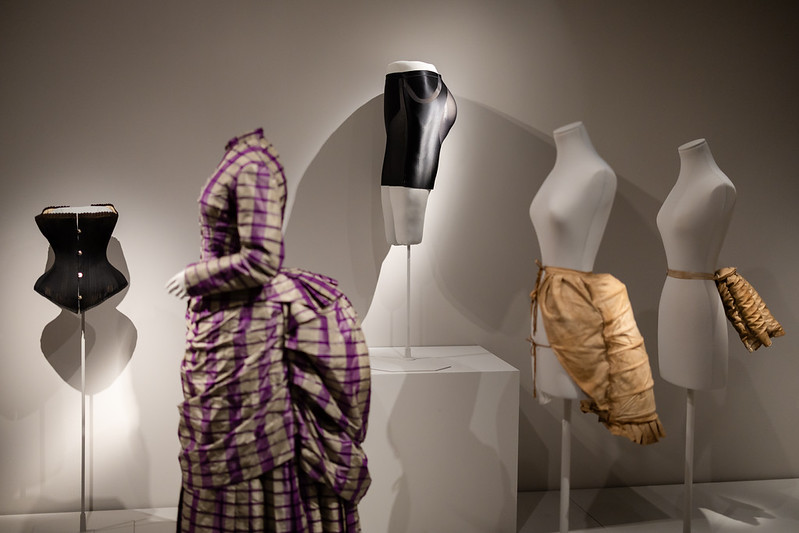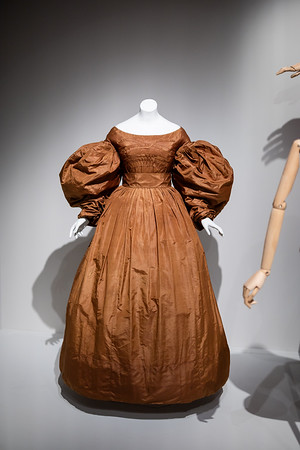An exciting new exhibition awaits at Historic Deerfield in Massachusetts. Set in the idyllic landscape of New England, Body by Design: Fashionable Silhouettes from the Ideal to the Real is a fascinating insight into the understructures that shaped the silhouettes of clothing from the sixteenth to the nineteenth centuries in the region.

Corset, Imported by James McCreery & Co. New York, Belgium, about 1890, Cotton satin weave, cotton lining, metal fastenings, Historic Deerfield, Deerfield, MA, T.106/021
Dress, England or United States, about 1885, Silk taffeta, lined with cotton, steel buttons, Historic Deerfield, Deerfield, MA, Gift of Mrs. Harold G. Duckworth, V.114
Booty Lifting Mid-thigh Short, SPANX Corporation, 2025, Nylon, Lycra® Elastane and Cotton. Private Collection.
Two Bustles, United States, 1880s, Cotton twill weave, cotton tape, metal, Historic Deerfield, Deerfield, MA, Gift of Mrs. Robert Sawyer Jr. from the estate of Mrs. Frederick Zappey, 73.026.3 and 73.026.
The exhibition is a part of a fall forum hosted by the museum with a focus on the history of New England and the evolution of its cultural perspectives. The curator, Lauren Whitley is proud to present this as her debut exhibition since joining Historic Deerfield in 2023. Previously a curator in the fashion and textile department of the Museum of Fine Arts in Boston, Whitley brings her wealth of costume history knowledge to the caretaking of the museum’s eight-thousand-piece textile collection. Her goal is to bring in a younger audience to connect with the past wearers of these pieces of clothing – an attempt to shed light on the fluid nature of garments and how they link us to the stories of the past. In this exhibition, Whitley touches upon the reworking of many of these garments where daughters have modified their mothers’ dresses to suit their own tastes. Apparently, a very New England thing to do and also very much in keeping with the ideals of sustainability in fashion today.

Composed of twenty-five pieces, this modest but visually rich exhibition of garments walks the viewer through the stories of garments worn by those in influential strata of society in the early modern period. The garments are accompanied by understructures, displayed side-by-side to highlight the painstaking effort required to achieve a body shape which was considered fashionable at the time. Many of the garments selected highlight a particular part of the human body – accentuating it to achieve a rather unnatural but evocative silhouette. The lineup boasts of nineteenth century hoops and bustles, shoulders and beautifully embroidered corsetry with the showstopper arguably being a red Madam Grès dress with extravagant sleeves.
Whitley talks about the human desire to alter one’s bodily proportions throughout history. Using Spanx as an example of a contemporary body modification apparatus, the curator of the exhibition discusses the evolution of the corset, suggesting that the undergarment never truly went away, only transformed to suit the times.
A notable corset on display in the presentation is one from the 1830s. An exquisitely quilted structure with cording (a technique of covering a string of cord with fabric in order to enhance a seam or an edge), this evocative piece of underclothing is a fine example of the wearer’s financial prowess as the garment would not have been seen by anyone else but the person wearing it and a very select few permitted to see such an intimate piece of clothing on the wearer.
Whitley also focuses on a man’s suit from the Samuel Dexter family, with a lineage based in Massachusetts. The fabric of this ensemble is woven from pink silk and gold thread, a combination likely chosen for its glorious appearance in candlelight.
The exhibition also includes garments which draw attention to the influence of non-Western craftsmanship on the region’s fashions of the time. A specific example of a man’s banyan (a garment of leisure to be worn within the privacy of the home) boasts of a block-printed chintz fabric from India, fashioned into the shape of a kimono. A common thread through most of these pieces is the display of wealth in places where audiences were not always too large – a precursor to what is perhaps now referred to as “quiet luxury.”

Left: Sleeve plumper, English, 1820-30, Cotton plain weave, down feathers, linen tape, Historic Deerfield, Deerfield, MA, Museum Collection Fund, 2015.12.1
Right: Sleeve supporters, American, about 1895, Steel wire and cotton, Historic Deerfield, Deerfield, MA, Gift of Louise Robinson Swainbank (Mrs. John A.), 1999.4.1ab
The exhibition walk-through concludes, funnily enough, with a contemporary garment designed by the Springfield-based Afro-Caribbean designer Richie Richardson, who acknowledges the collaborative nature of garment making, drawing attention once again to the beauty of human connectivity through clothing.
Body by Design: Fashionable Silhouettes from the Ideal to the Real is on display at the Flynt Center of Early New England Life May 3, 2025 – January 4, 2026.
